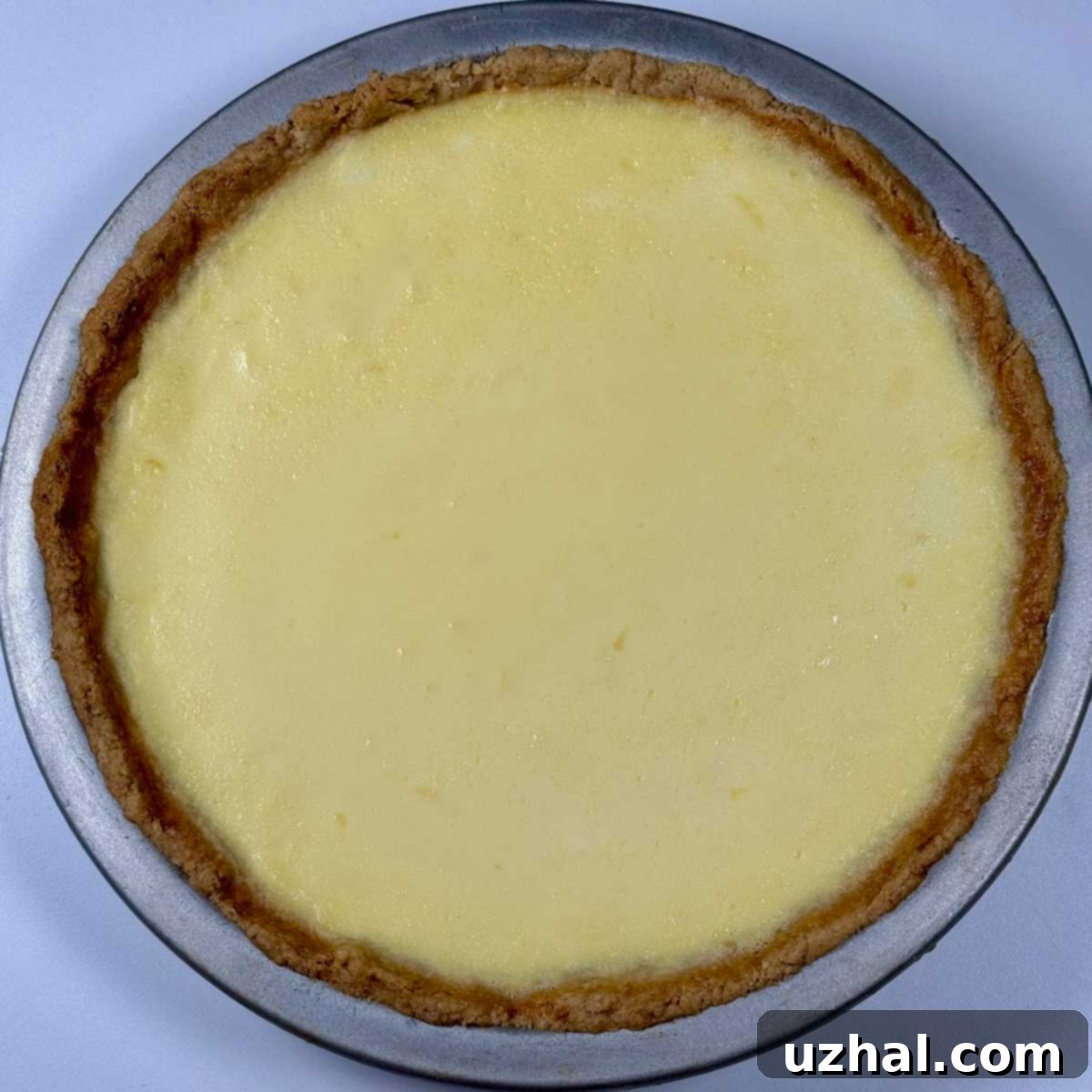Indulge in Creamy Bliss: The Ultimate Gluten-Free Ricotta Sour Cream Pie
Freshly returned from a journey, I found myself yearning for a new baking adventure. A dear friend, sensing my culinary curiosity, shared this delightful recipe: a Ricotta Sour Cream Pie. This exquisite creation promises a smooth, creamy Italian-style filling nestled within a perfectly crafted gluten-free cookie crust. While my usual dessert inclinations lean towards classic cream cheese cakes, this particular pie has truly opened my eyes to the wonders of ricotta-based desserts. It’s a revelation!
The first bite immediately transported me. My husband, a connoisseur of fine desserts, enthusiastically declared it “like cannoli in pie form.” Coming from him, that’s perhaps the highest compliment, as cannoli stands firmly among his all-time favorite treats. Indeed, it shares that wonderful, subtly sweet, and rich texture, though this pie boasts a brighter, more pronounced lemon zest that truly elevates the experience. It’s a sophisticated yet comforting dessert that perfectly balances tangy and sweet notes.
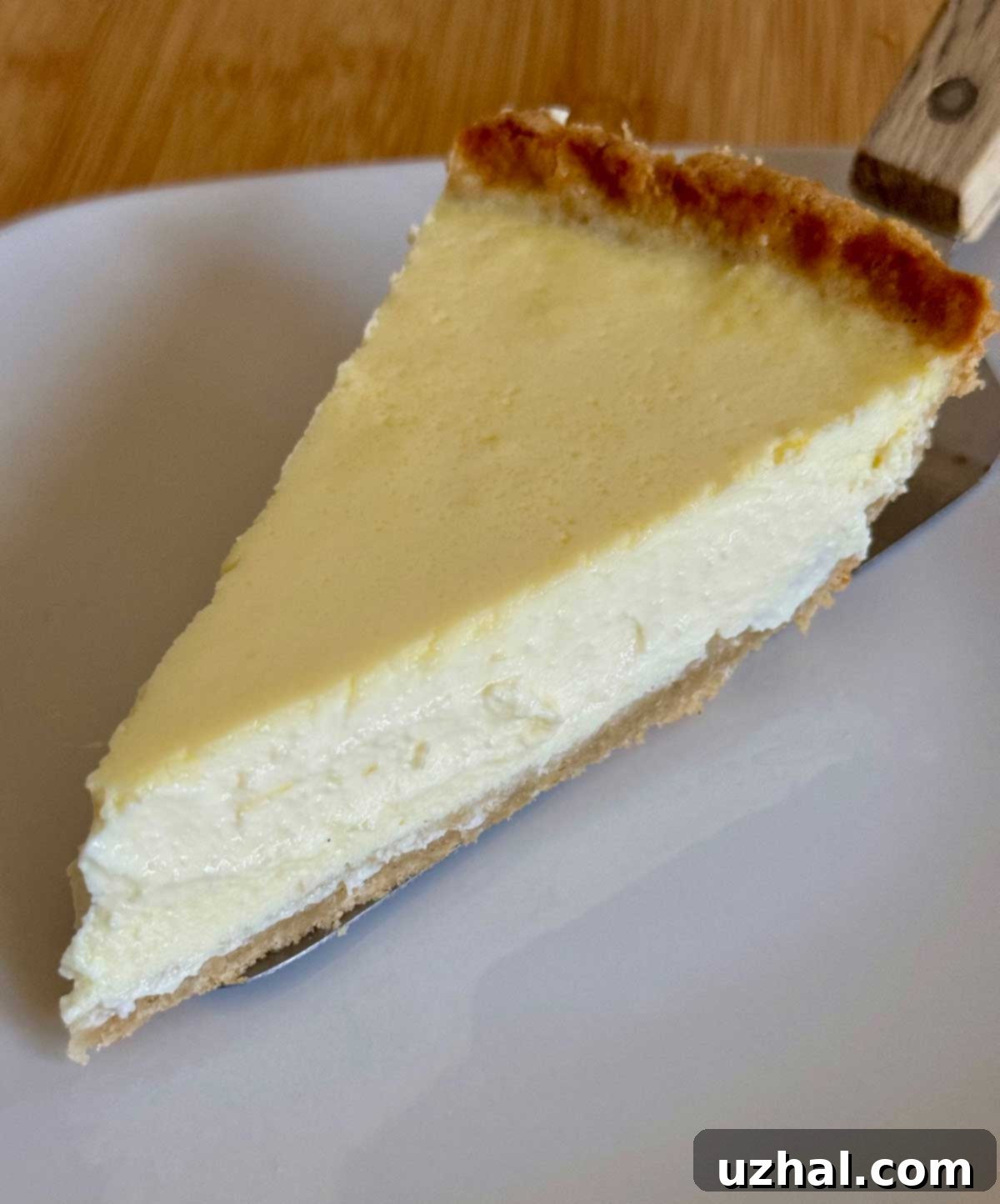
Crafting the Perfect Gluten-Free Crumb Crust for Your Ricotta Pie
One of the standout features of this Ricotta Sour Cream Pie is its incredibly simple yet flavorful gluten-free crumb crust. The recipe is remarkably straightforward, but it does call for a few specific gluten-free flours that, thankfully, are becoming increasingly accessible in most grocery stores and health food markets. I chose a harmonious blend of brown rice flour, almond flour, and oat flour, each contributing unique qualities to the final texture and taste.
Brown rice flour provides a sturdy, slightly coarse base, giving the crust structure. Almond flour adds a wonderful richness, a delicate nutty flavor, and a tender crumb, making the crust feel indulgent. As for oat flour, it’s a fantastic binder that imparts a lovely chewiness and a subtle, wholesome sweetness. You don’t even need to buy pre-made oat flour; for this recipe, I simply ground some rolled oats in my food processor until they reached a fine, flour-like consistency. This is a simple trick that ensures freshness and saves a trip to the store!
For those with nut allergies or who prefer to avoid nuts, there’s an excellent substitution option. My friend, who initially shared this recipe, often uses spelt flour in place of almond flour (using the same weight). While spelt is not gluten-free, for those who can tolerate it, it offers a similar flavor profile and a pleasant texture. If you need to keep it strictly gluten-free and nut-free, a high-quality gluten-free all-purpose flour blend (ensure it contains binders like xanthan gum) could work, though it might alter the nutty notes slightly. The beauty of this crust is its versatility and the distinct “nutty lemon shortbread cookie” taste it develops, especially after being partially baked before the filling is added.
The process involves pressing the flour mixture into the pie dish, creating an even layer that extends up the sides. This partial baking step, often called “blind baking,” is absolutely essential. It helps to set the crust, preventing it from becoming soggy once the creamy filling is added, and it enhances that irresistible, golden-brown flavor. This crust isn’t just a container for the filling; it’s an integral part of the pie’s overall deliciousness, offering a delightful counterpoint of texture and flavor to the smooth, rich filling.
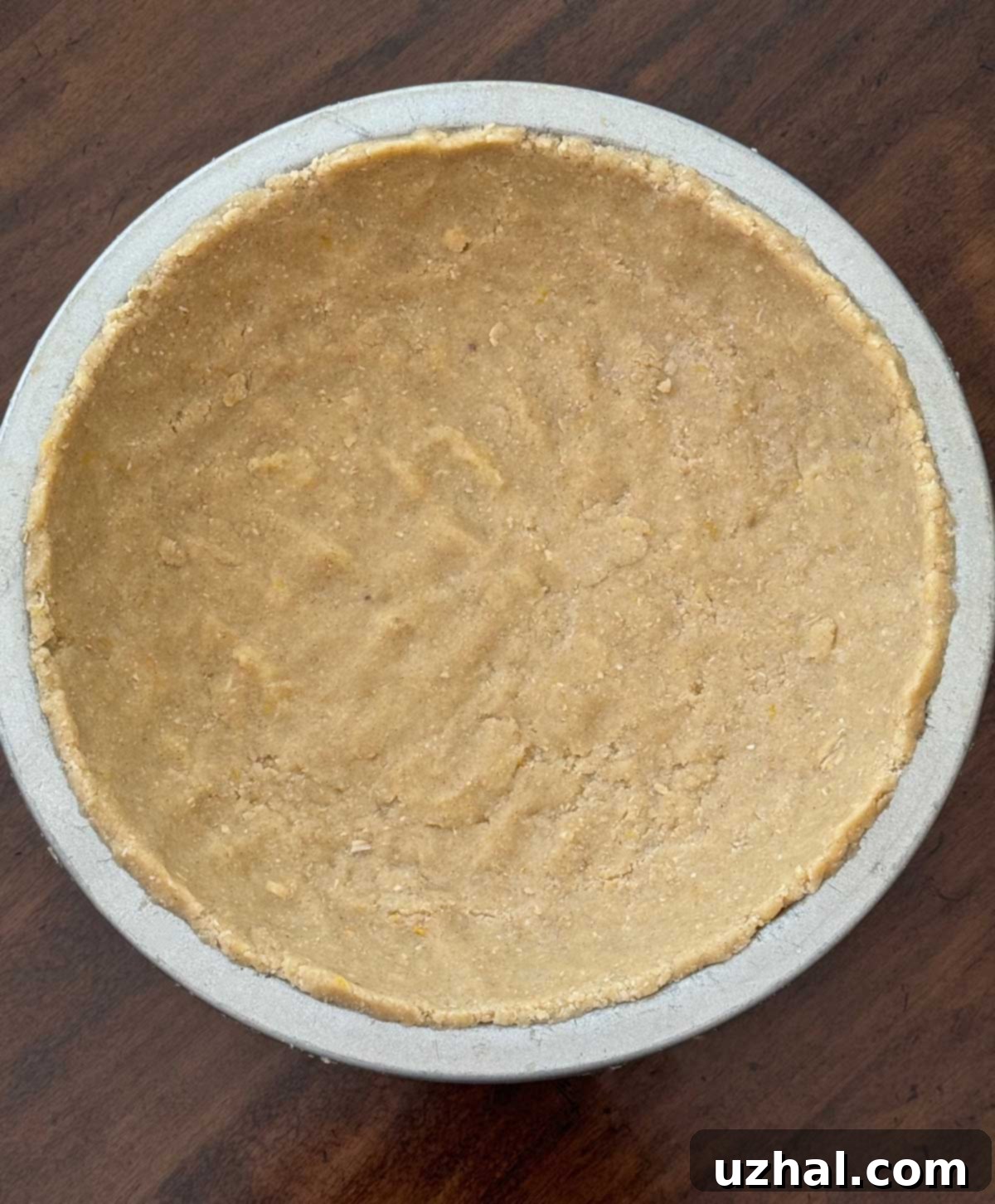
The Critical Step: Draining Ricotta Cheese for a Flawless Filling
Achieving the signature smooth, creamy, and lightly lemon-flavored filling for a Ricotta Sour Cream Pie hinges on one often-overlooked but crucial step: properly draining the ricotta cheese. This isn’t just a recommendation; it’s a non-negotiable requirement for a truly exceptional pie. Skipping this step can lead to a watery, less flavorful, and less cohesive filling that simply won’t set correctly.
Why is draining so important? Ricotta cheese, especially the varieties commonly found in supermarkets, contains a significant amount of whey (the watery part of milk). If this excess liquid isn’t removed, it will leach into your pie during baking, making the filling thin, loose, and prone to cracking. The goal is a dense, velvety texture that holds its shape beautifully when sliced. The level of creaminess and flavor intensity can indeed vary between brands, with some premium ricottas being naturally smoother and richer, but even the best ricotta will benefit from draining.
My preferred method for draining ricotta is both simple and effective. I spread the ricotta cheese (from a standard 425-gram carton, aiming for about 330 grams of drained ricotta) evenly over a thick stack of paper towels. The paper towels efficiently absorb the excess moisture. I let it sit for a good 20 minutes, which is usually enough time to draw out a substantial amount of whey. After this period, you’ll clearly see the moisture absorbed by the paper towels. Then, I simply scrape the now-denser ricotta directly into the mixing bowl with the other filling ingredients. This method is quick, clean, and requires no special equipment.
Alternatively, you can drain ricotta using cheesecloth. Line a colander with a few layers of cheesecloth, spoon in the ricotta, and place the colander over a bowl to catch the drips. You can let it drain in the refrigerator for a few hours, or even overnight, for a very firm ricotta. The longer it drains, the denser the ricotta will become. Whichever method you choose, the payoff is a lusciously smooth, firm, and flavorful pie filling that truly elevates this Italian dessert to new heights. Don’t underestimate the power of this simple preparation!

Balancing Bright Lemon with Rich Flavorings
The true character of this Ricotta Sour Cream Pie lies in the careful balance of its flavorings, particularly the generous use of lemon. Both my friend and I wholeheartedly agree: this pie needs a good amount of lemon to truly sing. The bright, zesty notes of fresh lemon cut through the richness of the ricotta and sour cream, preventing the pie from being overly heavy and adding a refreshing, vibrant dimension that makes each bite irresistible. We’re talking about zest, not just juice, as the zest carries the concentrated essential oils for maximum aromatic impact.
Vanilla is another classic flavoring often associated with creamy desserts. While vanilla may certainly be added to the filling, I opted to omit it, knowing that the gluten-free crust already boasts a delightful hint of vanilla paste. This decision ensures the flavors are complementary rather than competing, allowing the lemon to truly shine in the filling while the crust provides a warm, inviting base note. If your crust does not contain vanilla, or if you simply adore the flavor, a teaspoon of vanilla extract or paste in the filling would be a lovely addition.
For those accustomed to American-style cream cheese cakes, you’ll notice a distinct difference in the tartness profile of ricotta pies. Even with the inclusion of sour cream, the flavor of a ricotta pie tends to be milder, more nuanced, and less intensely tangy than its cream cheese counterpart. This is due to the inherent characteristics of ricotta, which is a softer, sweeter, and less acidic cheese than cream cheese. The sour cream provides a pleasant tang and adds to the overall creaminess, but it doesn’t dominate the flavor as much as cream cheese would.
Furthermore, the quality of your dairy ingredients is paramount. As with many simple recipes, the pie will only be as good as the brands of ricotta and sour cream you choose. Invest in full-fat, good-quality ricotta that has a fine, smooth texture when drained, and opt for a thick, rich sour cream. These premium ingredients will contribute significantly to the pie’s luxurious mouthfeel and depth of flavor. For an extra touch of sophistication, consider adding a whisper of orange zest alongside the lemon, or even a tiny splash of Grand Marnier or limoncello for a more adult dessert. A pinch of nutmeg can also warm up the flavors beautifully, especially for a holiday treat.
Ultimately, this Ricotta Sour Cream Pie is a testament to the elegance of simple, high-quality ingredients working in harmony. It offers a unique and memorable dessert experience that is both comforting and exhilarating, a perfect fusion of Italian tradition and modern gluten-free baking.
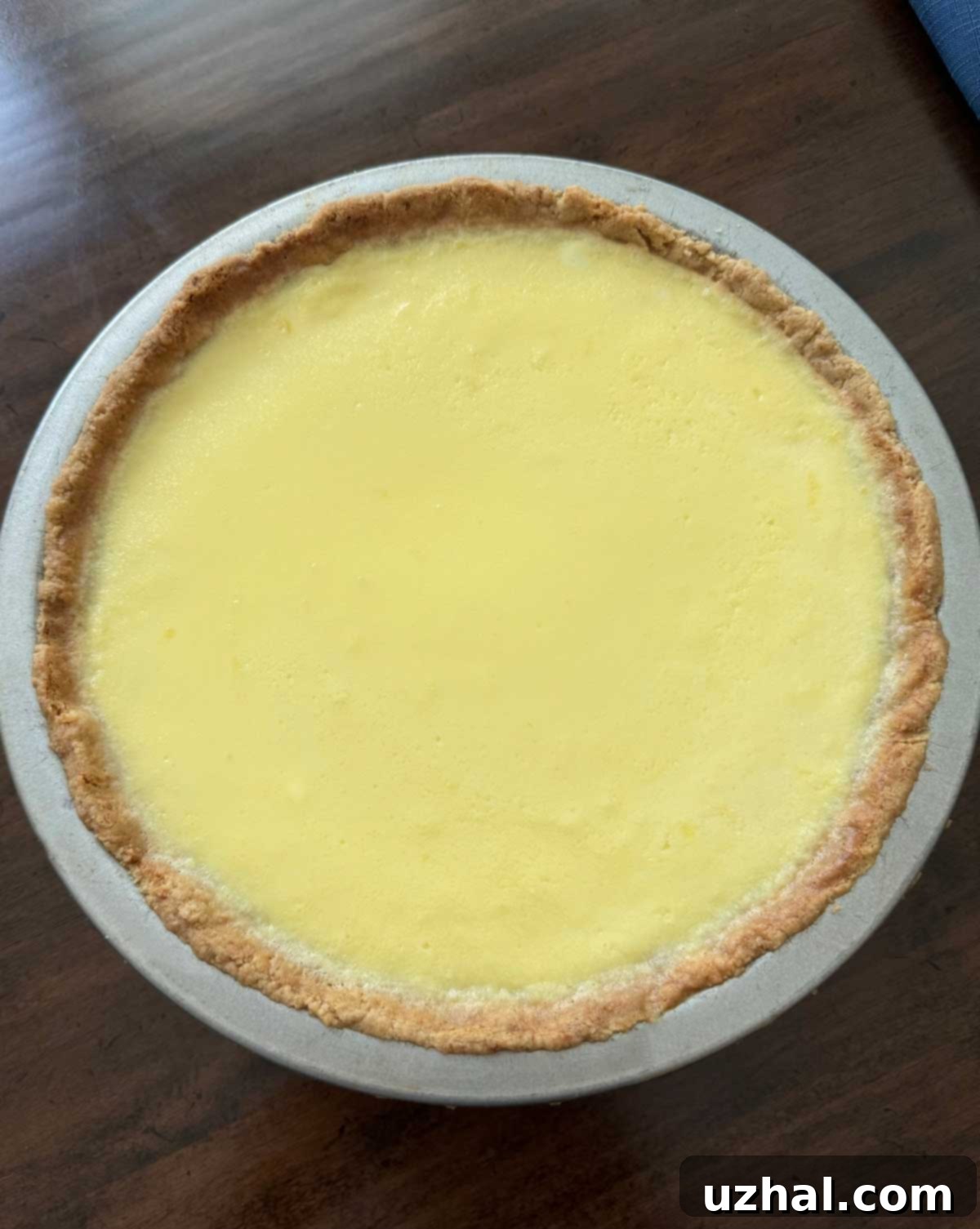
- Ricotta Muffins
- Ricotta Rum Chocolate Chip Muffins
- Ricotta Cheese Chocolate Muffins
- Small Batch Agave Oatmeal Chocolate Chip Muffins
- Italian Love Cake
Recipe
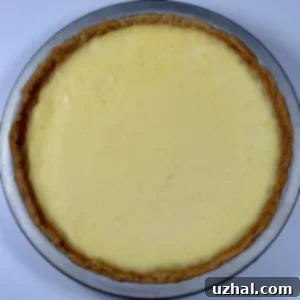
Ricotta Sour Cream Pie
Pin Recipe
Ingredients
For the Gluten-Free Crumb Crust:
- 80 grams brown rice flour (a rounded ½ cup)
- 60 grams almond flour (approx. ⅔ cup; for nut-free, substitute with spelt flour by weight if tolerated, or a GF all-purpose blend)
- 60 grams oat flour (½ cup; can be made by grinding rolled oats)
- ½ teaspoon fine sea salt
- ¼ cup granulated sugar (50 grams)
- 1 tablespoon fresh lemon zest
- 1 stick unsalted butter, melted and cooled (114 grams), plus a little extra for greasing the pie dish
- 2 teaspoons vanilla paste (or vanilla extract)
For the Creamy Ricotta Sour Cream Filling:
- 330 grams drained ricotta cheese (from one 425 gram/15 oz carton of full-fat ricotta)
- 170 grams full-fat sour cream (¾ cup)
- 100 grams granulated sugar (½ cup)
- 8 grams cornstarch (1 tablespoon, helps with setting)
- 120 grams heavy cream (½ cup)
- 2 tablespoons fresh lemon zest (zest of 1 large, fluffy lemon for maximum flavor)
- 2 large egg yolks (adds richness and helps with setting)
- ⅛ teaspoon fine sea salt (enhances all flavors)
Instructions
Preparation:
-
Preheat your oven to 350 degrees F (175 degrees C). Lightly grease a 9-inch metal pie dish. While a glass pie dish can technically work, a metal dish tends to conduct heat more evenly, resulting in a crispier crust.
-
Before you even think about the crust, begin draining your ricotta cheese. Spread the entire 425-gram carton of ricotta (even though you’ll use less after draining) onto a thick stack of paper towels. Let it sit and drain for at least 20 minutes while you prepare the crust. This step is crucial for a creamy, non-watery filling.
Making the Gluten-Free Crumb Crust:
-
In a medium-sized mixing bowl, combine the brown rice flour, almond flour, oat flour, ½ teaspoon salt, ¼ cup sugar, and 1 tablespoon lemon zest. Whisk them together until they are well combined. Then, pour in the vanilla paste and the cooled melted butter. Mix everything thoroughly, either with a spoon or your hands, until a uniform crumbly mixture forms and all the dry ingredients are moistened.
-
Transfer the crumb mixture into your greased pie dish. Use your fingertips to firmly press the mixture evenly across the bottom and up the sides of the dish, forming a neat, compact crust. For a clean edge, you can use the flat bottom of a glass or measuring cup to help smooth and press. Place the pie dish into the freezer for about 10 minutes to firm up the crust, which helps prevent shrinking during baking. Once firm, press a piece of parchment paper over the cold crust, then weigh it down with dried beans or ceramic pie weights. Bake for 20 minutes in the preheated oven.
Preparing and Baking the Filling:
-
While the crust bakes, prepare the filling. In a large mixing bowl, use a handheld electric mixer (or a stand mixer) to thoroughly blend together the previously drained ricotta (you should now have approximately 330 grams), sour cream, 100 grams sugar, cornstarch, heavy cream, 2 tablespoons lemon zest, egg yolks, and ⅛ teaspoon salt. Mix until the filling is completely smooth and no lumps remain. Don’t overmix, just enough to combine and achieve a uniform consistency.
-
Carefully pour the creamy filling into the warm, partially baked pie crust. Gently tap the pie dish on the counter a few times to release any air bubbles. Place the pie dish onto a baking sheet (this makes it easier to transfer and catches any potential spills). Bake for approximately 30 to 35 minutes. The pie is done when the edges appear set and slightly golden, but the center still has a slight, delicate jiggle when gently shaken. It will continue to set as it cools.
Cooling and Serving:
-
Once baked, remove the pie from the oven and let it cool completely at room temperature for about an hour. This gradual cooling is important to prevent cracks. After cooling, transfer the pie to the refrigerator and chill for at least 3-4 hours, or preferably overnight. Chilling is essential for the pie to fully set and for the flavors to meld beautifully. Serve cold, perhaps garnished with extra lemon zest or fresh berries, for an unforgettable dessert experience. Enjoy!
In conclusion, this Ricotta Sour Cream Pie is more than just a dessert; it’s an experience. Its creamy, lemon-kissed filling and delightful gluten-free cookie crust offer a refreshing alternative to traditional cheesecakes, embodying the elegant simplicity of Italian baking with a modern twist. Whether you’re a seasoned baker or new to the world of ricotta pies, this recipe is incredibly approachable and guarantees a stunning, delicious result. The subtle nuttiness of the crust perfectly complements the bright, smooth filling, making it a dessert that truly satisfies and leaves a lasting impression. Don’t hesitate to embark on this culinary journey – your taste buds will thank you!
